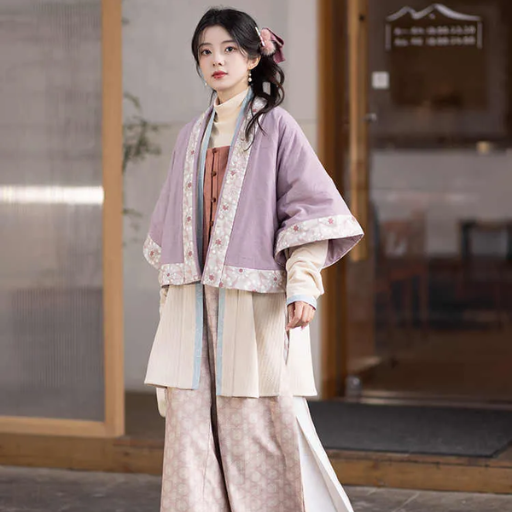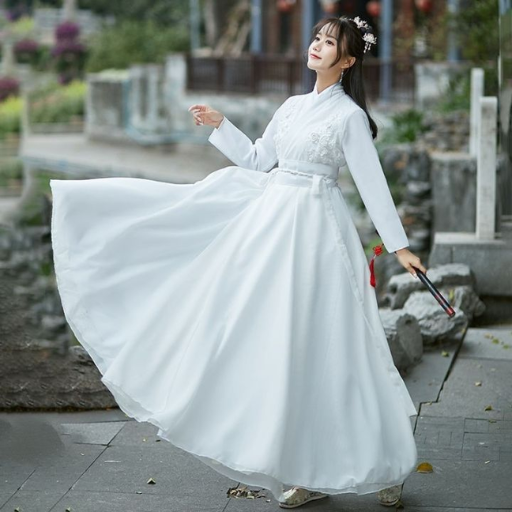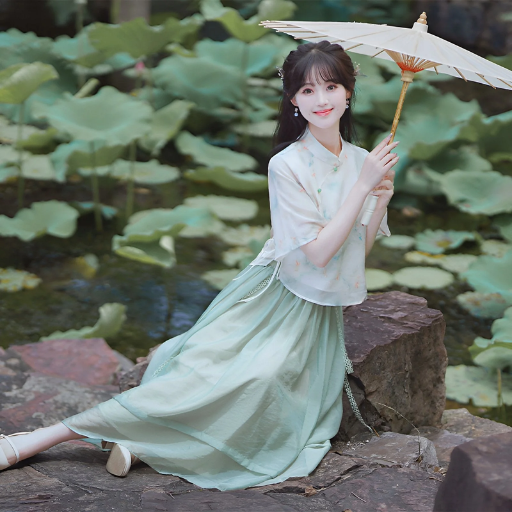Quick Facts:
- Market Value: Over 10 billion RMB (USD 1.4 billion) in 2022
- Active Enthusiasts: More than 7 million in China as of 2023
- Historical Span: Over 4,000 years of cultural heritage
- Growth Rate: Daily Hanfu wear is increasing by 15% annually in urban areas
Understanding Hanfu: From Ancient Tradition to Modern Revival

What is Hanfu?
Hanfu, meaning “Han clothing,” represents the traditional costume of the Han Chinese people, characterized by:
- Flowing robes with graceful silhouettes
- Wide sleeves that allow freedom of movement
- Cross-collar design that wraps across the front
- Cultural symbolism is embedded in every design element
The Historical Significance
Hanfu embodies over 4,000 years of Chinese cultural heritage, originally designed to reflect Confucian ideals of:
- Harmony – through balanced proportions and flowing lines
- Modesty – via generous coverage and elegant draping
- Social respect – expressed through elaborate decoration and quality materials
Key Features of Traditional Hanfu
| Element | Description | Cultural Significance |
|---|---|---|
| Yi (Upper Garment) | Narrow-sleeved top garment | Represents dignity and formality |
| Chang (Long Skirt) | Flowing lower garment | Symbolizes grace and femininity |
| Wide Sleeves | Generous sleeve openings | Indicates freedom and nobility |
| Cross-collar | Overlapping front closure | Represents traditional Chinese aesthetics |
Colors and Their Meanings
- Red: Prosperity, joy, and good fortune
- Blue: Tranquility, harmony with nature
- Pink: Love, youthful energy, modern expression
- Black: Power, formality, sophistication
- Yellow/Gold: Imperial status (historically restricted)
Materials and Craftsmanship
Traditional Hanfu emphasizes quality natural materials:
- Silk: Premium choice for formal occasions
- Cotton: Practical option for daily wear
- Hemp: Lightweight and breathable
- Modern synthetics: Affordable and easy-care alternatives
Modern Hanfu Trends and Popularity

Current Market Growth
2023 Industry Statistics:
- Market value exceeded 10 billion yuan (USD 1.4 billion)
- Primary demographic: Teenagers and young adults in their twenties
- 80% preference for Tang Dynasty styles in recent surveys
- 500,000+ mentions of #HanfuAccessories on social media
Popular Dynasty Influences
| Dynasty Style | Key Characteristics | Modern Applications |
|---|---|---|
| Ming Dynasty |
|
Daily wear, formal occasions |
| Tang Dynasty |
|
Performances, festivals, photoshoots |
| Song Dynasty |
|
Professional settings, daily wear |
Color Palette Trends
Modern Hanfu embraces both traditional and contemporary color schemes:
- Pastel Blue: “Sky blue” shades for tranquil elegance
- Blush Pink: “Rose” tones for youthful vibrancy
- Neutral Tones: Beige and ivory for versatile layering
- Bold Contrasts: Deep colors paired with light accents
Styling Tips for Modern Hanfu
Choosing the Right Style for Different Occasions
| Occasion | Recommended Style | Fabric Choice | Key Accessories |
|---|---|---|---|
| Daily Wear | Qixiong Ruqun, Song-style | Cotton, linen blends | Simple hairpins, comfortable flats |
| Festivals | Ming or Tang styles | Brocade silk, heavyweight fabrics | Elaborate embroidery, traditional ornaments |
| Weddings | Red Hanfu with Phoenix patterns | Premium silk | Gold accessories, ceremonial hairpieces |
| Performances | Dynasty-specific authentic styles | Flowing materials for movement | Period-appropriate hair ornaments |
Essential Styling Guidelines
- Balance tradition with modernity – Incorporate contemporary accessories thoughtfully
- Choose appropriate fabrics – Match material weight to occasion and season
- Master the art of layering – Combine tops and jackets for versatility
- Select complementary footwear – Embroidered flats or low heels work best
- Pay attention to hair accessories – They complete the authentic look
Cultural Significance of the Modern Hanfu Movement

Reviving Traditional Chinese Culture
Key cultural impacts include:
- Educational value: Teaching younger generations about Chinese history
- Cultural pride: Strengthening connection to ancestral traditions
- Creative expression: Providing a platform for artistic interpretation
- Community building: Creating networks of like-minded enthusiasts
Global Fashion Influence
Hanfu’s international impact includes:
- Runway integration: Elements appearing in Paris and New York fashion shows
- Fusion trends: Combining Hanfu elements with streetwear
- Social media reach: Viral content spreading awareness globally
- Cultural exchange: Fostering appreciation for Chinese aesthetics
Practical Considerations for Wearing Hanfu

Fabric Selection Guide
| Fabric Type | Best For | Care Requirements | Price Range |
|---|---|---|---|
| Silk | Formal occasions, elegant draping | Hand wash, air dry, low heat iron | High |
| Cotton | Daily wear, comfort | Machine washable, moderate heat | Medium |
| Synthetic Blends | Easy care, durability | Machine-friendly, wrinkle-resistant | Low-Medium |
| Hemp/Bamboo | Eco-friendly, breathability | Gentle wash, natural drying | Medium-High |
Care and Maintenance Tips
- Washing: Hand wash delicate fabrics, use gentle cycles for sturdy materials
- Drying: Air dry in shade to prevent color fading
- Storage: Use breathable garment bags, add natural repellents
- Ironing: Steam or low heat on the reverse side
- Stain treatment: Address immediately with gentle spot cleaning
Where to Buy Quality Modern Hanfu

Recommended Retailers
| Retailer | Specialty | Price Range | Best For |
|---|---|---|---|
| Hanfu Story | Detailed embroidery, premium fabrics | High | Special occasions, collectors |
| The Hanfu Times | Sustainable materials, cultural education | Medium-High | Environmentally conscious buyers |
| YesStyle | Affordable variety, modern conveniences | Low-Medium | Beginners, casual wear |
| Etsy | Custom designs, handcrafted pieces | Variable | Unique, personalized items |
Shopping Tips
- Check customer reviews for quality assessment
- Verify size charts and return policies
- Consider shipping times for international orders
- Look for authentic materials and craftsmanship
- Start with basic pieces before investing in elaborate designs
Frequently Asked Questions
What is modern Hanfu?
Modern Hanfu refers to contemporary adaptations of traditional Chinese Hanfu clothing that maintain historical authenticity while incorporating modern fabrics, colors, and practical design elements for today’s lifestyle.
How is modern Hanfu different from traditional?
Modern Hanfu differs in materials (using cotton, synthetics alongside silk), construction methods, and practical adaptations for daily wear, while preserving the essential aesthetic and cultural elements of traditional designs.
Can modern Hanfu be worn for daily activities?
Yes, many modern Hanfu designs are specifically created for comfort and versatility, making them suitable for daily wear, work, and casual social activities.
What materials are used in modern Hanfu?
Modern Hanfu utilizes silk, cotton, linen, hemp, bamboo fiber, and high-quality synthetic blends that offer durability, comfort, and easy care while maintaining elegant appearance.
What role does Hanfu play in Chinese culture?
Hanfu serves as a bridge between past and present, helping preserve Chinese cultural heritage while allowing modern expression of traditional values, aesthetics, and identity, especially among younger generations.
Reference Sources
1. Cornell University: Preservation: The Identity that is Passed On
Talks about the growing popularity of modern Hanfu, different varieties of modern Hanfu and why it how going back in traditional wears helps in cultural identity.
2. Polytechnic University of Catalonia (UPC): Kansei Evaluation on Hanfu Style Diversities
This evaluates whether the elements of traditional Hanfu can be incorporated in contemporary apparel and how consumers perceive the same.
3. Iowa State University: Sleeveless Dress Pattern Plan
Preserves the depiction of Hanfu, because it focuses on the Hanfu movement in the world of young Chinese people involving the mixing of the old and the new.







